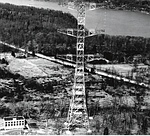The Armstrong Tower
Although it is hard to miss, for most of us the tower isn’t more than just a familiar part of our landscape for as long as we can remember. Many of us can see it from at least one window in our house, especially at night. All of us have driven past it countless times. Standing at 425 feet above the top of one of the highest sections of the Palisades, the three-tiered Armstrong FM Tower in Alpine, New Jersey is unique in not just its appearance but also its history. Constructed in 1938 by Lamont Scientist Edwin Armstrong, the tower was the site of the first FM radio station in the world.
Born in 1890, Edwin Armstrong had been an inventor since his childhood. As a junior at Columbia University, Armstrong invented a radio circuit that enabled radio signals to be transmitted over great distances allowing transatlantic transmission. Shortly after the discovery, another scientist unassociated with Armstrong, claimed to be the true inventor. Armstrong sued and eventually lost the case that made it all the way to the Supreme Court. The scientific community however still credits Armstrong with the discovery.
In 1933, after a stint in the military, Armstrong secured a patent for the invention of frequency modulated radio or FM radio as we know it by today. Varying the frequency of the signal rather than the amplitude allowed FM radio transmission to carry voice and sound much clearer than AM allowed at the time. In 1938, Armstrong spent $300,000 of his own money to construct a tower on property near his childhood home. After completion of the tower, Armstrong began to operate the first FM station in the world out of a small radio shack on the property that still stands today and houses a small collection of his original equipment. The station call sign W2XMN remains engraved above the entryway to the building.
As FM grew in popularity, large companies began building and selling FM equipment, often ignoring Armstrong's patents. After losing his legal battles earlier in his life Armstrong was determined not to let it happen again and threw much of his financial and emotional resources into patent infringement lawsuits. During his long legal battles against some of the nation's largest and most powerful companies, Armstrong could not accept the possibility of losing again and took his own life at the age of 64. In a bittersweet ending to his story, his wife Marion continued to pursue the lawsuits for 13 years after his death, eventually winning all 21 of them.
The tower that bears his name is still very active today. It rises close to 1000 feet above sea level and acts as an important visual waypoint for aircraft as well as hosting numerous transmitters. Perhaps the tower's greatest moment was on September 11th, 2001 when it became the primary transmitter site for many TV and radio stations that previously relied on the World Trade Center, thus allowing uninterrupted broadcasting of critical news and information. One station, WNBC, was a former RCA station—one of the companies that Armstrong fought and eventually defeated in court.


